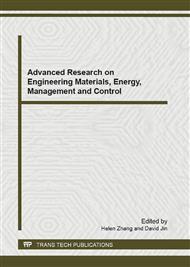p.410
p.415
p.420
p.424
p.430
p.435
p.439
p.445
p.448
Removal of Gas-Phase Elemental Mercury by Photocatalytic with Liquid Absorption
Abstract:
In order to study the influence of UV irradiation, treat temperature of nano-titanium dioxide and intensity of UV irradiation on the mercury removal performance, experiments were carried out on a photocatalytic oxidization system to find the best experimental conditions. Commercial Degussa P25 was used as a photocatalyst loading on titanium mesh, and the mercury removal efficiency was stable at 8% in the absence of UV irradiation. Under the UV irradiation of 300W mercury lamp, the mercury removal efficiency surged to 100%. With the same light intensity, the same removal time, the mercury removal efficiency of nano-titanium dioxide calcinated at 100°C reached 92.2% after 0.5h while the mercury removal efficiency of nano-titanium dioxide calcinated at 500°C reached 93.6%. Intensity of UV irradiation has a positive impact on the mercury removal performance.
Info:
Periodical:
Pages:
430-434
Citation:
Online since:
January 2012
Authors:
Keywords:
Price:
Сopyright:
© 2012 Trans Tech Publications Ltd. All Rights Reserved
Share:
Citation:


